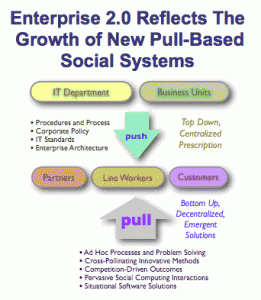Interesting commentary from Dion Hinchliffe about the changing business landscape being heralded on the back of the Enterprise 2.0 space, which Forrestor predicts will be a $4.6 billion (£2.3 billion) within 5 years.Dion goes on to reference the two major methods by which these new applications take hold. The first is the traditional model where the IT department or some part of the business decides at a high level to adopt these new tools and begins the process of evaluation, acquisition, deployment, training and adoption. This being the traditional model that most IT large-scale software acquisitions still use today.The other model is where individuals take it upon themselves to find the best solutions to a given problem at hand and solve them creatively and collaboratively at a grassroots level. This model is becoming increasingly more common, particularly in organisations that are less strongly hierarchical.
I should note that I’m witnessing this ‘push’ model at first hand through the rapid take-up of social networking and social media applications across the local government sector as part of the development of communities of practice across the sector. The conundrum here is that this is happening across almost exclusively hierarchical organisations.I fully concur on Dion’s conclusion that:
“The challenge will be learning how to apply these new models effectively to business while not strangling them with the traditional aspects of enterprise software that can greatly limit their potential and have led to poor outcomes and excessive structure in the past. The good news: Most likely they will be hard to stop as Web 2.0 applications become increasingly commonplace in our organizations over the next few years. The bad news: Most organizations will take years learning how to create environments that fully allow the leverage of these tools.”
This latter point resonates with my own experience in promoting Web 2.0 technologies and processes for facilitating more effective collaboration and knowledge sharing across the traditionally silo’d mentality of public sector organisations. There’s a tendency for some people to get mesmerised by the technology at the expense of investing time and effort in creating a collaborative workplace.I believe it’s a classic case of applying the ’80:20′ rule, i.e. for every £20 (or $20) spent on the technology, organisations should be investing £80 (or $80) on ensuring its being used effectively. In other words, don’t assume that everyone in the workplace has the skills to collaborate effectively, and recognise that sometimes the culture may be working against open collaboration.
